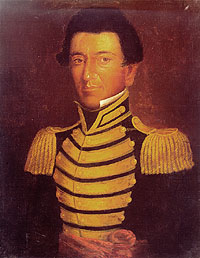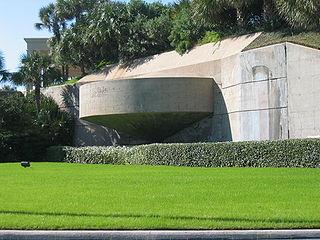
The Alamo Mission, commonly called the Alamo and originally known as the Misión San Antonio de Valero, is a historic Spanish mission and fortress compound founded in the 18th century by Roman Catholic missionaries in what is now San Antonio, Texas, United States. It was the site of the Battle of the Alamo in 1836, where American folk heroes James Bowie and Davy Crockett died. Today it is a museum in the Alamo Plaza Historic District and a part of the San Antonio Missions World Heritage Site.

The Daughters of the Republic of Texas (DRT) is a lineal association dedicated to perpetuating the memory of the founding families and soldiers of the Republic of Texas. The Daughters of the Republic of Texas is best known for its former role as caretakers of The Alamo. In early 2015, Texas Land Commissioner George P. Bush officially removed control of the Alamo to the Texas General Land Office. The DRT were also the custodians of the historic French Legation Museum until 2017, which is owned by the State of Texas and is now operated by the Texas Historical Commission. In addition, they operate a museum in Austin on the history of Texas.

The Battle of the Alamo was a pivotal event in the Texas Revolution. Following a 13-day siege, Mexican troops under President General Antonio López de Santa Anna reclaimed the Alamo Mission near San Antonio de Béxar, killing most of the Texians and Tejanos inside. Santa Anna's cruelty during the battle inspired many Texians and Tejanos to join the Texian Army. Buoyed by a desire for revenge, the Texians defeated the Mexican Army at the Battle of San Jacinto, on April 21, 1836, ending the rebellion in favor of the newly-formed Republic of Texas.

Juan Nepomuceno Seguín was a Spanish-Tejano political and military figure of the Texas Revolution who helped to establish the independence of Texas. Numerous places and institutions are named in his honor, including the county seat of Seguin in Guadalupe County, the Juan N. Seguin Memorial Interchange in Houston, Juan Seguin Monument in Seguin, World War II Liberty Ship SS Juan N. Seguin, Seguin High School in Arlington.

The Alamo is a 2004 war drama film about the Battle of the Alamo during the Texas Revolution. The picture was directed by John Lee Hancock, produced by Ron Howard, Brian Grazer, and Mark Johnson, distributed by Walt Disney Pictures, and starring Dennis Quaid as Sam Houston, Billy Bob Thornton as Davy Crockett, Jason Patric as Jim Bowie, and Patrick Wilson as William B. Travis. The screenplay is credited to Hancock, John Sayles, Stephen Gaghan, and Leslie Bohem.

Susanna Wilkerson Dickinson and her infant daughter, Angelina, were among the few American survivors of 1836 Battle of the Alamo during the Texas Revolution. Her husband, Almaron Dickinson, and 185 other Texian defenders were killed by the Mexican Army.

Fort Crockett is a government reservation on Galveston Island overlooking the Gulf of Mexico originally built as a defense installation to protect the city and harbor of Galveston and to secure the entrance to Galveston Bay, thus protecting the commercial and industrial ports of Galveston and Houston and the extensive oil refineries in the bay area. The facility is now managed by the US NOAA National Marine Fisheries Service, and hosts the Bureau of Commercial Fisheries Laboratory, the Texas Institute of Oceanography, as well as some university facilities. The area still contains several historical buildings and military fortifications.

The Arlington Line was a series of fortifications that the Union Army erected in Alexandria County, Virginia, to protect the City of Washington during the American Civil War.

The Immortal 32 was a relief force of thirty-two Texian Militia from the Gonzales Ranging Company who reinforced the Texians under siege at the Alamo. They are "immortalized" as the only unit to answer the To the People of Texas & All Americans in the World letter. Along with the other Alamo defenders, they were all killed and burned after the Battle of the Alamo.
Juana Gertrudis Navarro Alsbury was one of the few Texian survivors of the Battle of the Alamo during the Texas Revolution in 1836. As Mexican forces entered her hometown, San Antonio de Bexar, on February 23, Alsbury's cousin by marriage, James Bowie, brought her with him to the Alamo Mission so that he could protect her. Bowie, the co-commander of the Texian forces, collapsed from illness on the second day of the siege; Alsbury nursed him throughout the remainder of the siege. On March 4, Texian co-commander William Barret Travis sent her as an emissary to Mexican commander Antonio Lopez de Santa Anna to negotiate an honorable surrender for the Texian forces. She made no headway, and her visit likely increased Santa Anna's impatience to end the siege in a spectacular fashion. Santa Anna launched an early-morning assault on the Alamo on March 6.

Fort C.F. Smith was a lunette that the Union Army constructed in Alexandria County, Virginia, during 1863 as part of the Civil War defenses of Washington. It was named in honor of General Charles Ferguson Smith, who died from a leg infection that was aggravated by dysentery on April 25, 1862. Fort C. F. Smith connected the Potomac River to the Arlington Line, a row of fortifications south of Washington, D.C., that was intended to protect the capital of the United States from an invasion by the Confederate States Army.

The Battle of the Alamo left a substantial legacy and influence within American culture and is an event that is told from the perspective of the vanquished.

Martyrs of the Alamo is a 1915 American historical war drama film written and directed by Christy Cabanne. The film is based on the historical novel of the same name by Theodosia Harris, and features an ensemble cast including Sam De Grasse, Douglas Fairbanks, Walter Long and Alfred Paget. Fairbanks role was uncredited, and was his first role in film, although his first starring role, in The Lamb, was released prior to this picture. The film features the siege of Béxar, the Battle of the Alamo, and the Battle of San Jacinto.
Amos Pollard was the chief surgeon at the Battle of the Alamo and died during the battle on March 6, 1836.

The Alamo Cenotaph, also known as The Spirit of Sacrifice, is a monument in San Antonio, Texas, United States, commemorating the Battle of the Alamo of the Texas Revolution, which was fought at the adjacent Alamo Mission. The monument was erected in celebration of the centenary of the battle, and bears the names of those known to have fought there on the Texas side.

The 2nd Regiment, Texas Infantry was an infantry regiment from Texas that served with Confederate States Army in the American Civil War. The regiment was organized by the then Captain John Creed Moore who would become the regiment's 1st Colonel. Many of the men were from Houston and Galveston.

Fort Tillinghast was a small lunette that the Union Army constructed in Alexandria County, Virginia, as part of the Civil War defenses of Washington. Fort Tillinghast stood about 0.6 miles away from Arlington House, the Union-occupied estate of Confederate General Robert E. Lee.

Second Flying Company of San Carlos de Parras, also known as the Álamo de Parras Company, were Spanish lancers from San José y Santiago del Álamo in Coahuila. Their 1803 occupation of the San Antonio de Valero Mission is reputed to be the reason the mission was renamed "the Alamo." The compañía volante were mounted militiamen active during the Viceroyalty of New Spain's occupation of Tejas (Texas). During the occupation, a military hospital was established and the mission's structure was expanded to facilitate its function as a military fortification.















